CARRIERS
AT SHARDLOW
|
|
written 22 January
2000 , updated 6 October 2016
|
|
|
written 28 January
2000, updated 3 Dec 2013
|
|
|
written 14 April 2000
|
|
|
written 1 December 2000, updated 6 October 2016
|
|
|
written 25 January 2002
|
|
|
written 27 January 2002
|
|
|
|
| James Sutton and
the Shardlow Boat Company; Broughton and Sutton |
Broughton and Sutton expanded 6 Oct 2016
|
The first Sutton that appears in our
records is Thomas (? to 1814). He is in the village in 1775 recorded in
the Town Book receiving expenses as a village official. His earliest
known project is building the Navigation Inn 1788-9. In the early 1790's
he also builds the two houses which adjoin the warehouse (no. 34 on the
1852 plan) and the butchers shop which adjoined the Navigation Inn. Between
1792
and 1817, together with his son James (1767 - 1830) he builds a large cottage,
a small cottage and a salt warehouse on the triangle of land between the
river Trent, the canal and the turnpike road (number 7 on the 1852
plan). This James Sutton (nicknamed 'old bag' by the villagers, after a
scandal) is reputed to have started his working life as a simple boatman
(George Gilbert memoirs) - he was later to possess considerable wealth,
including ownership of Shardlow Hall as a result of his business success
especially in the salt trade. In 1795/6 James is in occupation of the Navigation
Inn and a lease in 1818 shows that he had a riverside wharf on the
Derbyshire bank upstream of Cavendish Bridge, where the river runs close
to the turnpike road. By then he has a teenage son, another James (1801-1868).
There are records of Upper Trent
Boats being built by the Shardlow Boat Company for their own use from 1774
to 1785, the most recent of these was sold in 1796. We do not have evidence
of a connection between this company and the Sutton's at that time.
Thomas Sutton was a regular supplier
of coals to the Shardlow Overseer of the Poor as early as January 1803
which implies that he was carrying then. James the elder purchased Trent
sailing boats from 1808 and by 1820 was trading as 'James Sutton and the
Shardlow Boat Company'. However the name James Sutton and Co. continued
to appear after 1820, presumably as an abbreviation. With the competition
from the railways the family fortunes decline and James Sutton the younger,
faced with a re-evaluation of his property for assessing the amount of
poor rates he must pay, bemoans in 1851 that '....we think the Property
over rated and if he [John Bromley 1852 surveyor] used Sanders [1837 surveyor]
(in dear times) valued at certain rates it will influence him in valuing
in these very low times.' [letter from Sutton to Soresby Nov 4 1851
- Derbyshire Record office 1326A/P057]
By 1850 the Suttons have stopped
building boats. By 1858 they had closed their wharf in Derby, and the 1860
Directory for Shardlow no longer lists them as Canal Carriers - although
James Clifford, close friend and former partner is then listed as a general
carrier.
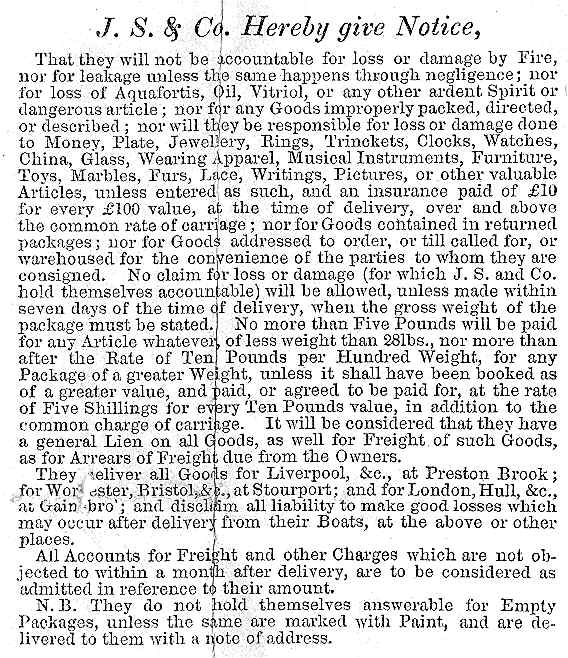
enlarged reverse of the below ticket

the ticket for shipment of 5 bells,
wheels etc. for Shardlow Church April 26 1841
the bells were cast at the Whitechapel
foundry (London) and were taken as far as Coventry by Messrs Morris Herbert
and Co
Shardlow Boat Company and Sutton's
Boats
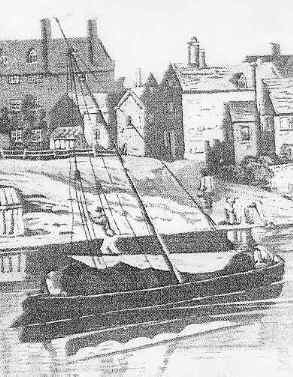
|
Upper Trent Boats
The Trent Navigation Company gauging
tables show Upper Trent Boats owned by the Shardlow Boat Company from 1774,
and at the time of measurement 1799 the 2 early boats had jury mast and
line (for hauling or towing), and the boats built 1785 and 1795 had mast
and sails. The tables show that Sutton & Co was operating Upper
Trent Boats with large mast and sail between Shardlow and Gainsborough
from 1808, salt from Shardlow to Gainsborough being a principal cargo.
Corn and malt to Shardlow is also listed , as is 'Trade' between the two
ports.
These boats were approximately 72
feet long by 14 feet wide, with considerable individual variation - the
largest was 76' 5'' by 14' 1'' and was built by Wood and Tingle at
Shardlow. The tables do not give names for the boats.
(We have not yet reviewed the Trent
Navigation Tables for 1816 - 1854, but we know that Sutton boats are plentiful
in these)
The tables for 1855 onwards indicate
that by then Sutton's may have finished trading, only being listed
as previous owners of several boats. |
Sutton Narrowboats
The Trent Navigation Tables for
1855 do include 2 narrowboats built by Sutton & Co at Shardlow in 1838
and 1840. These boats had width of only 6' 6'' and 6' 8'' respectively,
so may have been used as flyboats. We have not yet seen any gauging records
for Sutton's boats on the canal system.
Some of Sutton's narrowboat names
in 1831 were:
Expedition, Speedy, Norway, Robert,
Zealous, Hambro, Northwood, Swift, Safety
Sutton Employees
Names of boat masters on Trent boats
were: Thos Crane, Joseph Woolley, Josh. Woolley, James White, and John
Tomlinson. There will be more names in the portion of Trent Navigation
Tables that we have yet to review.
We know of more than 40 names of
narrowboat captains working for James Sutton from the 1830's to 50's of
whom just a handful have been identified in the Shardlow census records.
The family of whom we know most is that of Samuel Till senior and junior:
Till, Samuel junior
[died 14 Nov 1872 aged 51, buried in Shardlow churchyard with his wife
and daughter Diana]
Schedule76 1851 census
Shardlow Lock
| NAME |
AGE |
OCCUPATION |
BORN |
| Samuel Till |
29 |
Canal Carriers Boatman |
Middlewich |
| Catherine |
26 |
|
Shardlow |
| Edward |
5 |
|
Shardlow |
| Joseph |
3 |
|
Shardlow |
| Diana |
10 months |
|
Shardlow |
Samuel Till is listed in the 1852 Poor
Rate Survey living at plot 179 owned by Holden [no. 7 on our 1852 plan]
We think built by Thomas Sutton (photo much enlarged background of small
snapshot from 1930's)
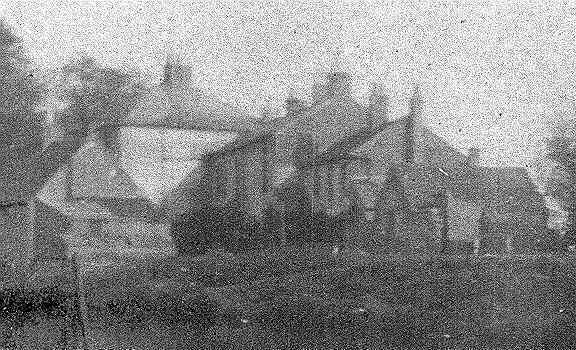
Canalside - Plot 179 on 1852 plan
|
1861 census - Boats on the
Canal - 'Swift'
| Edward Till |
15 |
captains son |
Shardlow |
| Joseph Till |
13 |
captains son |
Shardlow |
from Cargo records
| Samuel Till senior |
Feb 12 1844 |
1 truss hosiery |
Leicester to Middlewich |
|
|
|
|
| Samuel Till junior |
July 29 1850 |
40 loads malt in 48 sacks |
Shardlow to Middlewich |
|
|
|
|
| Samuel Till junior |
Aug 3 1850 |
1 box starch,
1 hogshead sugar,
1 chest tea,
1 bag coffee,
1 tin molasses |
Liverpool to Middlewich |
|
| Joseph Cubley |
from Swarkestone |
a clerk in Mr Sutton's
office |
| Joseph Gilbert |
from Loughborough |
a warehouseman |
| Jonathan Glasby |
from Yorkshire |
a clerk to Mr Sutton |
| George Wilkinson |
from Gainsborough |
ropemaker to Mr Sutton |
| Sam Shepherd |
from Weston |
Mr Sutton's blacksmith |
The 1832 Cholera epidemic
had dreadful consequences for one of James Sutton's boat families. The
Derby Mercury of 12 Sept 1832 reports:
'We understand a case of cholera
occurred at Shardlow on the 2nd. The person afflicted was the wife of a
boatmaster in the employ of Messrs Sutton & Co. A meeting of the inhabitants
was convened on the following Sunday, James Sutton Esq. in the chair, when
it was resolved to fit up a vessel as a temporary hospital afloat on the
river Trent.'
Sutton's cargo
Entries in the 1827 and 1850 Directories
show the extent of the trading network:
| 1827 - Conveyance by water. James
Sutton and Shardlow Boat Company's fly boats, every day to Derby, Market
Harborough, Hull, Sleaford, Loughborough, Leicester, Nottingham, Grantham,
Lincoln, Newark, Boston , Gainsborough, Horncastle, Manchester, Melton
Mowbray, etc.: also conveyance to all places on the line of the Trent,
Mersey, and Bridgewater canals.
1850 - CONVEYANCE BY WATER. To LEICESTER,
DERBY, HULL, Sleaford, Lincoln, Nottingham, Gainsborough, Liverpool, Manchester,
Birmingham, the Staffordshire Potteries, Cheshire Salt Works, Stourport,
Wolverhampton, Stourport, Coventry, and all parts of Yorkshire, Jas. Sutton
& Co's Fly Boats, daily; goods forwarded to all parts of the Kingdom. |
From the records at Ellesmere Port
Boat Museum which cover 1842 - 1850 (with gaps) the total variety of goods
is fascinating but those from Shardlow are confined to malt, beans, oats,
barley, flour, timber and the odd 1/2 hogshead of vinegar.
Examples of other shipments are
as follows:
| 1842 |
1 box of hats |
from Manchester to Middlewich |
| 1843 |
5 bundles of spades |
from Preston to Middlewich |
| 1843 |
3 sacks of seeds |
from Etruria to G. Geesby, Middlewich |
| 1843 |
1 cask of ale |
from Stoke to Mr Greatbatch, Middlewich |
| 6 Mar 1847 |
1 box of candles |
from Leek to James Wall of Chester
- landed there (9 Mar 1847) |
| 1847 |
60 bags of malt |
from Shardlow to R. Longton of Winsford
- note several bags
in a very wet state |
5 July 1850 James Drakefield
travels to Middlewich from Stoke with vinegar. On the 13th he is in Middlewich
again with a cargo of matches from Manchester, he returns to Middlewich
from Liverpool on the 22nd, from Shardlow with malt on the 25th and from
Liverpool with tea and flour on the 29th.
In September of 1850 he is
in Middlewich from Manchester with candles on the 21st, from Leicester
with 1 truss on the 26th and from Liverpool with molasses on the 30th. |
Broughton and Sutton
The title 'Broughton and Sutton'
appears in Glover's Directory in 1827 as 'Broughton and Sutton -
salt men - Shardlow' and is recorded as a boat owner in the Trent Navigation
Tables between 1804 and 1815. Four boats are listed, No.1 to No.4, being
Upper Trent Boats with large mast and sail, purchased between 1804 and
1809, and the last record shows one being sold in 1815 (The other
boats may have continued in use for years without needing re gauging, as
implied by the 1827 Directory entry). They carried salt from Shardlow
to Gainsborough, and two of the masters were John Sutton and Thos Johnson.
It is natural to assume that the
company name refers to the Broughton after which Broughton House
was named, the house which had been built by Thomas Sutton who died
in 1814. We do not have any records of Broughton residing in Shardlow,
and this connection needs further investigation. Maybe he came from the
Cheshire end of the salt trade? The boat master John Sutton was not descended
from Thomas Sutton, but may have been related.
6 October 2016: The following information from the Cheshire end has been supplied by Trevor Ellis:
Broughton & Sutton
1821 - 29?
This firm appear only in Pigot & Dean's 1821-22 Directory carrying to London, Litchfield, Fazeley, Tamworth, Derby, Nottingham, Sheffield, the Potteries, Chester, Warrington, Stockport, Rochdale, Halifax, Huddersfield, Leeds, Liverpool and all parts of the North, from Castlefield Warehouse, Manchester, agent William Toplis. "Huddersfield" is included among the range of places to which they carry, many on narrow canals, though no places are specified which are only on the Huddersfield Narrow Canal, whereas Rochdale and Halifax are included on the wide-beam route. James Sutton & the Shardlow Boat Company are also listed at the same place and with the same agent, carrying to Derby, Loughborough, Leicester, Nottingham, Newark etc.
The Chester Courant 12 April 1825 carries a brief advertisement "The Public are requested not to pay any money on our account to Peter Joynson, our late agent, he having been dismissed from our employ. Broughton and Sutton, Wheelock Salt Works." The advert is repeated in the Chester Chronicle on the 15th.
The Chester Courant 4 October 1825 carries an announcement of a General Meeting of the British Rock and Patent Salt Company. Among its Directors are H.D. Broughton and James Sutton. Again the announcement is repeated in the Chronicle on 7th.
The Chester Courant 29 May 1827 contains an announcement that payment will be made on certain notes issued by "the late Nantwich Bank." Among the signatories of the notes are a Broughton and a Sutton.
The Manchester Courier 07 March 1829 under "Partnerships Dissolved" includes "H.D. Broughton and J. Sutton, Lawton, Wheelock and Roughwood, Cheshire."
The Leeds Mercury 25 July 1840 includes an advertisement by James Sutton & Co., who describe themselves as "General carriers on the Bridgewater Canal, Trent & Mersey Navigation and Rivers Trent and Soar" to say that they have just concluded an agreement with the Midland Counties and North Midland Railway Companies. The firm give an address at the Navigation Wharf in Leicester, so this would seem to be the Sutton in question earlier and this part of the partnership appears to have continued.
| Soresby and Flack,
J and W Soresby |
written 28 january 2000 |
The Soresby family moved to Cavendish
Bridge from Eyam in Derbyshire sometime after 1758. James, with his wife
Sarah and his recently widowed mother Elizabeth, may have come to
join Edward Soresby and his family. Edward built the last ferry to operate
at Wilden before Cavendish Bridge was opened in 1760.
The earliest reference is in the
Derby Mercury 5th July 1771:
"Yesterday pm, accident in Derby
- John Wright waggoner to Mr Soresby of Cavendish Bridge - in loading some
red lead near St Marys Bridge, a barrel rolled back out of the wagon
and falling upon his breast killed him on the spot."
 |
The family moved to Shardlow on
the news of the proposal for the canal, buying a large plot of land given
to Richard Attenborough at the Enclosure award in 1760. The canal
bisected the land providing the Soresby's with two areas for wharfs and
warehouses, (marked 21 and 29 on the 1852 plan). In the 1770's they built
the family home 'the Lodge', recently known as the Lady in Grey (30) and
raised two children, James (1766 - 1837) who took over the business
on his father's death in 1790 and Elizabeth (1771 - 1806) who married James'
partner, William Charles Flack in 1799. On their marriage Elizabeth and
William lived in the Firs (20) |
.
James and Elizabeth (nee Stevenson)
had six children, two of whom died in their teens. The two remaining sons
inherited the business (W C Flack had died in 1831) which runs from 1837
as J[ames Stevenson] and W[illiam Charles] Soresby. The daughters Elizabeth
(1807 - 1886) and Jeannette (1815 - 1886) lived with James (1804 - 1870)
who never married, at the family home until their deaths. William (1811
- 1868) married Rebecca Holbrook and moved to Nunsfield House, Alvaston,
Derby.
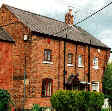 |
In the declining years of the carrying
business, the family was also involved in the cotton mill at Great
Wilne and built a steam corn mill in 1860 on Millfield (26 on the 1852
plan) which was burnt down in the 1890's. The granary, office, stable block
remain, all very much altered.
. |
The last entry we have found for the
carrying company is 1860, and in the same year Joshua Fellows bought 10
of James Soresby's boats according to Soresby family records.
Charles Holbrook Soresby, (William's
son) returned to live in the Firs c. 1910 and his grand-daughter still
lives in the village.
Soresby Property
In addition to the two wharf and
warehouse plots already mentioned as owned by the Soresbys, in the early
years they tenanted the areas numbered 7 and 35 on the 1852 plan and possibly
built the 1780? warehouse. They were also tenants of the Liversage Trust
and had land and property in Derby on the Morledge beside the Markeaton
Brook.
Lease on plot of land, part of
old bowling green, in the Morledge - Derby April 1806 for 60 years.
between Mssrs Soresby and Flack
and the Liversage charity trustees. The land "is now in the occupation
of the said James Soresby and W C Flack and upon which they have lately
and at their own expense erected and built, or are now erecting and building,
a dwelling house and other buildings (576 sq yds) by the Morledge Brook
the surface or soil of which for a depth of 6 1/2 feet has lately been
cut and taken away for the purposes of widening and making the said brook
navigable. Year rent £13 - 10s -. And before the end of three years
cause to be erected such other good and useful buildings as will make the
same premises with those now erected to be always of the yearly value of
£20 - 5s - and finding ropes for the capstan and supporting and keeping
in repair the capstan" ........"the capstan is at the mouth of the Morledge
Brook for assisting navigation of boats and other vessels passing out of
the river Derwent into the Morledge brook to and from the Holmes Mills"
Soresby Boats
In 1702 a document listing charges
for building the new ferry (Wilden Ferry) shows:
'paid to Ed Soreby for building
her £24 - 10s -
paid to Ed Soreby for 2 days
more £- - 2s -
We have not established that there
is a connection between this Soreby and the later Soresby family.
The Trent Navigation Company gauging
tables show three wide boats belonging to Soresby and Co c. 1780 - 1800
having small jury mast and lines, built by Benjamin Clifford at Shardlow.
One ('boat no. 4') is recorded as carrying coal to Shardlow but the others
had already been sold on, yielding no information on their use by Soresby.
Between 1796 and 1838 boats appear
under Soresby and Flack ownership, fleet number 7 onwards, their highest
fleet number being 24.
Like the Sutton boats, they are about
72 ft by 14 ft but with considerable variation, plus two at about 60 ft
6 ins by 12 ft 6 ins (trading Shardlow to Leicester) and one at 51 ft 6
ins by 11 ft (trading Shardlow to Nottingham).
The larger boats traded Shardlow
to Gainsborough, with large mast and sail, as did one of the 60 ft boats.
The 50 ft boat had a jury mast and line. The largest of their boats was
No 22, built by Soresby and Flack in Shardlow, being 76 ft 3 ins by 14
ft 3 ins.
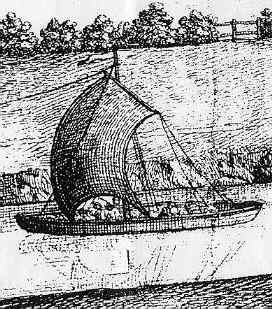
an Upper Trent Boat
The last recorded gauging is for boat
No. 3 in 1841, although they could have traded for many more years without
the need for re-gauging (required only after alterations to the boat).
There are two Soresby and Flack narrowboats
in the above table, and being only 6 ft 6 ins and 6 ft 8 1/2 ins beam,
they may have been part of their flyboat fleet
When James the younger died in 1838
the Company name changed to J and W Soresby - the last two recorded weighings
being in that name (1838 and 1841)
We do not yet have any records of
their narrowboats being gauged on the canal system.
Many of their boats were built by
Benjamin Clifford of Shardlow - we believe he was located at the dockyard
owned by Soresby (no 21 on the 1852 plan) because we know that by 1841
Samuel Clifford was located there, and continuing there in 1852.
The Soresby family records show that Joshua Fellows bought 10 of Soresby's
boats in 1860 - "8 Trent boats and 2 canal boats".
Soresby Cargoes
| Entries in the 1827, 1850 and 1860
Directories show the extent of the trading network:
1827 - Conveyance by water:
Soresby and Flacks fly-boats 4 times
a week to Derby, Leicester, Loughborough, Manchester etc.
also to all places upon the line
of the Trent, Mersey and Bridgwater canals
1850 - Conveyance by water:
To London, Liverpool, Manchester,
Derby, Leicester, Loughborough, and intermediate places
J & W Soresby's and Pickford
& Co's boats daily
1860 - Carriers
by water
Soresby James & William C -
Shardlow Wharf
|
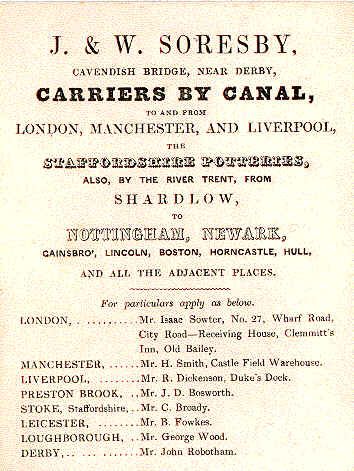 |
|
J. & W. Soresby's business card
|
Apart from saying that they carried
just about anything it is difficult to be specific as we have little hard
information.
Most of the cargo tables say that
they are employed in "trading". We know from the notice of John Wright's
death that they carried red lead and from the tables that one boat was
employed in bringing coal to Shardlow in 1800.
Three surviving invoices for 1843
at the Boat Museum add a little information:
Jos or Jas Williamson master.
Etruria wharf to Middlewich 17 February
1843
1 bundle of hoops and 1 bundle of staves
to R. Beck, Chester from Mr Whittaker of Hanley |
John Potts master.
Brassingtons Wharf, Stoke to Middlewich
28 March 1843
1 hamper of goods for John Carney, to
be called for at Middlewich |
William Williamson master
from Stone, Field Wharf to Middlewich
5 February 1843
4 bundles lead? to Charles Sproston,
Carrier at Middlewich - to be delivered immediately |
Soresby Employees
The earliest known employee is Mr
John Wright the waggoner who was killed in 1771 (see above).
Then in 1792 we have our earliest
boatman. When John Smith took soundings of the River Trent to update his
own of 1786 and those of Jessop in 1782 he was:
"attended in the above Survey by
John Beighton, Joseph Sheffield, and John Hickon, three persons who are
Master- men of Boats belonging to the Grand Trunk Canal, the Burton Boat
Company, and Mr Soresby, I was enabled to take the foregoing Soundings,
pretty accurately."
From the early boat cargo tables
(gauging records of T. N. Co.) we have the masters of Soresbys boats being
weighed in these years:
| Cowlishaw, J |
1800 |
| Robotham, R |
1801 (narrowboat) |
| Vickers, Jno |
1811 |
| Turner, Christopher |
1811 |
| Kemp, Richard |
1811 |
| Slater, Joshua |
1811 |
| Bosworth, Perc |
1814 |
| Elliott, J |
1814 |
| Beeby, John |
1814 |
| Kilbourn, J |
1814 |
| Ironmonger, R |
1815 |
John Vickers must be the same as one
of the two John Wickers in the following extracts from the
'1816 list of inhabitants - not
parishioners of Shardlow':
| Henry Smith |
|
Castle Donington |
clerk Mr Soresby's office |
| Sarah |
|
|
|
|
|
|
|
| Thomas Thorpe |
|
Shipley |
boatman to Mr Soresby |
| Dolly wife |
|
|
|
| Thomas |
|
|
|
| Anna |
|
|
|
|
|
|
|
| John Wickers |
|
[Burton on Trent scored out]
Willington |
boatman Mr Soresby's |
| his wife (scored out) |
|
dead |
|
| John |
|
|
married and lives in house of Mr
Soresby |
| Thomas |
|
|
a soldier |
| Ann |
|
|
married |
| Nathaniel |
14 |
|
|
| William |
12 |
|
|
|
|
|
|
| John Wickers |
|
[Burton on Trent scored out] Willington |
boatman Mr Soresby |
| Sarah |
|
|
|
| Betsy |
3 |
|
|
| Eliza |
1 |
|
|
|
|
|
|
| Martin Wardle |
|
|
Mr Soresby's sailmaker |
| his wife |
|
|
|
| George Gilbert's [1817 - 1880's]
memoirs - |
|
"....most of the men employed in
the wharves and working the boats belonging to the two local firms of Sutton
and Co. and the Messrs Soresby and Flack resided in the numerous villages
which surround this place but chiefly at Castle Donington."
George's brother Thomas b. 16 February
1812 in Shardlow, after leaving school, went to work for Mssrs Soresby
and Flack the river and canal carriers. He became a clerk in the office
but died 3 July 1833, buried in Castle Donington. |
| John Potts |
|
48 |
boatman |
Shardlow |
| Ann |
wife |
47 |
|
" |
| John |
son |
19 |
labourer |
" |
| Ann |
daughter |
12 |
|
" |
| Robert |
son |
10 |
|
" |
| Mary |
daughter |
8 |
|
" |
We can tell from the 1852 poor rate
survey that the family lived in part of plot 276 owned by George Cowlishaw
which means that they occupied the third house from the far end of
the row of 20 on Long Row.
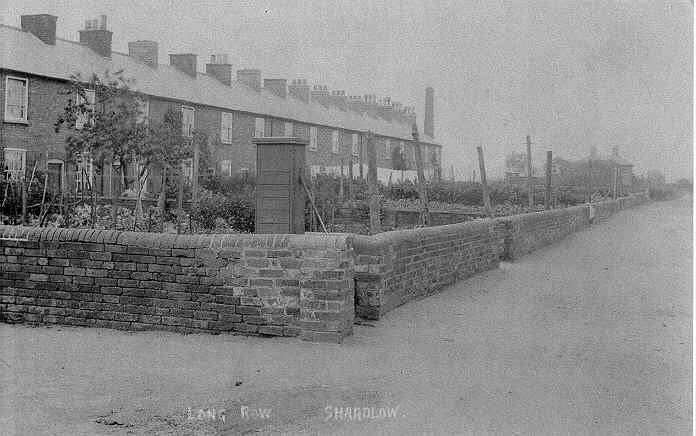
Cowlishaw Row [Long Row] where John
Potts and family lived in 1851
By 1861 John Potts had become an agricultural
labourer.
We may know even more about John
Potts as he could be John, the son of Thomas who appears in the 1816 list
of inhabitants as follows:-
Thomas Potts
Sarah
Thomas
John
Samuel
Sarah
Alice
Mary
Robert
Billy |
Castle Donington |
Boatman, settlement
gained by service with
Mr Wright - Donington Park |
Thanks to Soresby's
descendants
We are in contact with several descendants
of the Soresby family who are all being very helpful. They have lent us
photographs, family histories and family trees and are still searching
for other material which may add to the story.
| The
Cowlishaws |
written 14 April 2000
|
The Cowlishaw
family was a long established farming family in the village before the
coming of the canal. The family homestead was on the corner site between
London Road and Aston Lane (opposite the Dog and Duck). Here the senior
branch of the family built and lived in the present Shardlow House (see
'1882 map' and 'a Walk Through the Village') which is on the site of their
previous residence.
The earliest
record we have of the Cowlishaws on the waterways is from the Trent Navigation
Company's Gauging Tables. George Cowlishaw bought an 8 year old boat second-hand
in 1792, and it was gauged in 1799, 73 ft by 14 ft 2 ins with mast
and sail, carrying coal to Loughborough and Leicester, and corn etc. from
those places to Shardlow.
George Cowlishaw
received payments from the Shardlow Overseers of the Poor, for regular
deliveries of coals to the poor, every few weeks throughout the winter
e.g. Jan 13 1803 George Cowlishaw for coals £1 - 1s - 0d
In 1799 George
was assessed for duties and paid 12 shillings duty on 2 horses used for
business purposes. He also paid for one '4 shilling dog', and 4 shillings
and 6 pence for a house with 6 windows.
The horses
appear again in his will (probate 13 October 1812) :
'I give and
bequeath unto my eldest Son John Cowlishaw and to my third Son William
Cowlishaw my Boat with the (?Lines) Ropes Poles and all other Implements
and Appurtenances thereto belonging and my Horses with all the Tackle and
Gearing belonging to them equally to be divided between them my said two
Sons share and share alike.'
John Cowlishaw
(1779 - 1845) is recorded as Master of Soresby and Co boat No 4 in 1800,
carrying coal to Shardlow. In 1805 he purchased his boat No 1 (74 ft 5
ins by 14 ft 3 ins) from the Gainsborough Boat Company (who had built it
at Shardlow in 1798), and this was reweighed August 1812 when he was carrying
coal on the Erewash Canal. He appears again as owner/master of boat No
1 in 1816.
In the 1828
directory, John and William Cowlishaw are listed as coal merchants at Shardlow,
but are not listed in the 1835 onward directories.
William (1789
- June 1862) had 2 children Mira and William Joseph and in
later life describes himself as a proprietor of houses and land, and a
rate and tax collector. He lived at Holly Villa, at the corner of Long
Row and Wilne Lane. See below for more about his son William Joseph (1854
- April 1918).
Returning to John Cowlishaw (1779 - 1845), he had 3 children - Sarah
(1819 - 1891), John Dewsnop (1824 - 1884) and George (1827 - 1882).
| John Dewsnop takes over the family wharf (No. 28 on the 1852 plan)
in the late 1850's, probably in 1858 on the death of his mother Hannah.
This wharf had been run for some years (at least since 1835) by Philip
Burton who also occupied 'the Lawn' as a tenant. |
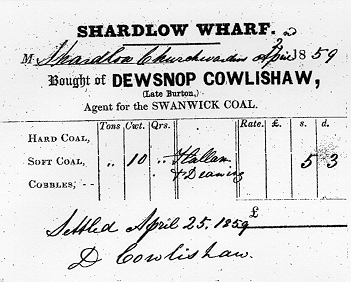 |
The 1861 census shows 'the Lawn' being occupied by:
| John Dewsnop Cowlishaw |
Head |
Coal Merchant |
| George Cowlishaw |
Brother |
Clerk in carriers office |
| Sarah Cowlishaw |
Sister |
Housekeeper |
George Cowlishaw was listed in Directories as the Agent to Joshua Fellows
& Co between 1864 and 1874. As Joshua Fellows bought James Soresby's
boats at the end of 1860 and set up his local depot here in 1861, we suggest
that George was Clerk to Mr Soresby and transferred to Joshua Fellows employ
at this time.
Returning to George's cousin William Joseph (1854 - 1918) he seems to
start his own business in 1887, combining being a coal merchant with the
office of Assistant Overseer to the Poor.
William Joseph Cowlishaw's boats appear in the Trent Navigation Company
Tables and the Ilkeston Register of Canal Boats (to register the boats
as a dwelling). He is believed to have run 3 boats at any one time although
there appears to have been replacement of some of the fleet at sometime.
The Ilkeston Register describes 3 boats each with cabin (the Registration
also gives cabin dimensions and cubic capacity) as follows:
| Ilkeston Reg. No. |
Boat Name |
Date of Record |
Event |
Master |
| No. 37 |
'Shardlow' |
6 October 1887 |
Registration |
John Woolley |
|
|
16 November 1909 |
Inspection |
Bradley |
|
|
11 May 1910 |
Inspection |
Bradley |
|
|
9 August 1916 |
Inspection |
G. Sheffield |
|
|
20 May 1920 |
Inspection |
G. Sheffield |
| |
|
|
|
|
|
Route: |
Shardlow to Shipley and Langley Mill |
|
|
|
Cargo: |
Coal: |
|
|
|
Propulsion: |
Horse |
|
|
|
Max. number of persons: |
In aft cabin, 3 persons |
|
|
|
|
The 1909 inspection specifies it as a wide boat. |
|
|
| |
|
|
|
|
| No. 38 |
'Admiral Dundas' |
6 October 1887 |
Registration |
John Woolley |
|
|
19 July 1910 |
Inspection |
? (3 men) |
|
|
9 Nov. 1911 -'this boat is in full working order' |
note |
|
|
Route: |
Shardlow to Shipley and Langley Mill |
|
|
|
Cargo: |
Coal and Coke |
|
|
|
Propulsion: |
Horse |
|
|
|
Max. number of persons: |
2 Adults
1 Child under 12 |
|
|
| |
|
|
|
|
| No. 39 |
'The Hope' |
9 May 1888 |
Registration |
James Woolley |
|
|
(no subsequent records) |
|
|
|
Route: |
Shardlow to Shipley and Langley Mill |
|
|
|
Cargo: |
Coal |
|
|
|
Propulsion: |
Horsepower. Wide Boat |
|
|
|
Max. number of persons: |
In aft cabin, 4. |
|
|
We have a photo of this boat in Shardlow Lock, showing the Ilkeston Registration
number.
The Trent Navigation Company also records 3 boats, but does not quote
their names, and one was not built until 1892, and did not join the Cowlishaw
fleet until some time later, and appears to be a narrowboat (judging by
hold length and gauging weights/freeboard - unfortunately the table omitted
the length and beam measurements...). Maybe this boat was a replacement
for the original 'Hope'.
The Trent Navigation Co. records are summarized:
No. 2151 (late 1529) Reweighed 24 Jan 1903. Master - H. Hackett
Built by Samuel Clifford of Shardlow in 1838, for a previous owner.
W. J. Cowlishaw purchased in year (unknown).
Rebuilt by W. J. Cowlishaw in year (unknown).
74 ft 9 ins by 14 ft 2 ins with 2 Trent lines
No. 2155 (late 1903) Reweighed 16 March 1903. Master - W. Webster.
Built by Joseph Barnsdall of Nottingham Trent Bridge in 1841, for William
Jackson of Newark.
W. J. Cowlishaw purchased in year (unknown).
71 ft 3 ins by 13 ft 10 ins with jury mast and Trent lines.
No. 2173 Weighed 18 March 1905. Master - D. Brown.
Built by Mssrs Rudkin Bros. of Leicester about 1892 for Messrs Kendal
& Co of Nottingham.
Length and Beam not recorded. Hold length 48 ft, max. gauged load 30
tons.
W. J. Cowlishaw purchased about 1901.
Two newspaper articles quote Mr. John Nash's memories of Cowlishaw in
the 1890's. One article is from Nunews, the cutting is undated but believed
to be from the 1970's and the other, from which the quotations are taken,
is from the Long Eaton Advertiser 21 March 1975. John describes the following
trip taken with his father who was one of Cowlishaw's boatmen:
"At Cowlishaw's coal wharf .... coal was brought by horse-drawn boats
from the various coal pits via the Erewash Canal. My father was a boatman
and sometimes he would take me on these trips.
I was not very old for I was wearing petticoats and skirts at the time.
It was all right going down for I had the empty hold to play about in.
But coming back with the boat loaded I had to stay in the cabin or in the
well deck.
I well remember one of those journeys. We had just cleared Sawley Lockhouse
Lock into the River Trent. I had managed to climb up on to the bow and
was watching the bow cutting through the water.
Old Joe Sabin, who lived in Long Row, was at the helm when he drew
my father's attention to my dangerous position. I can just remember being
snatched off the bow, hard across his knee, my clouts being turned up and
having a good belting, After this I had a leather belt around my waist
and a piece of rope fastened to it - so it was a case of so far and no
further."
The article in Nunews lists the boat names and their Captains:
Shardlow (Capt. J Bradley), Hope (Capt. W Webster), Admiral Dundas
(Capt. Beeley from Castle Donington).
The Cowlishaw boats were used for the village annual outings before
the first world war:
"Once a year we had our annual treat. Mr. Cowlishaw would have one
of his wide boats cleared out. Zachary Smith would supply barrels. Ellis
the joinery works on the Wharf would supply timber to be placed on top
of the barrels to make seats. One of Cowlishaw's boat horses would be dressed
up in coloured ribbons, its hooves black-leaded and polished. On Saturday
afternoon all the village kids would load up and we would set off to Weston
Cliff for tea and sports."
The two photographs are of the 1913 and 1910 boat trips, Capt. Webster
is standing in the boat nearest the balance beam on the left hand photo.
The right hand photo shows the awning that was erected to protect the women
and children.
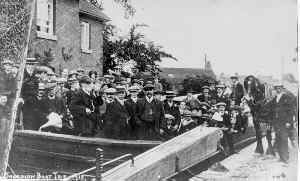 |
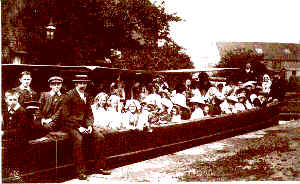 |
|
Boat trip 1913
|
Boat trip 1910
|
The Cowlishaw family are responsible for erecting many of the buildings
in the port area. Henry, the brother of George whose story began this section,
sold the latter some land for the wharf and the house, 'the Lawn', which
George built in 1795. As Henry was unmarried, he also gave an important
piece of land to George's children to be divided among them equally. The
land had been allocated to Poulson at the Enclosure of the village in 1758
and had been separated by the canal in 1770 into two very unequal parts.
The land to the South of the canal (No. 27 on the 1852 plan) was given
to William, whose sons sold it. Part of the land to the North of the canal
(No. 25 on the 1852 plan) was laid out as a road (originally called Cowlishaw's
Row, now Long Row) and all of the children got together and in about 1840
built a row of 20 houses, owning 4 each and the plot on the opposite side
of the road on which two of them built a further two short rows of 4 houses
each. Many of these were occupied by boatmen (see section on Soresby with
photo). In 1891 Cowlishaw's boatman John Woolley lived here with his wife
Charlotte and his grandson.
John Nash was also involved in the distribution of the coal:
"When I grew up I joined several other lads and with some home-made
barrows, we would call on Mr. Cowlishaw to see if he wanted any coal
taking out to the local houses. This would be half a hundredweight or one
hundredweight at one shilling per hundredweight. After several journeys
we would receive anything from a ha'penny to tuppence. I can tell you we
felt like millionaires when we went into John Pegg's toffee shop for a
farthing bull's eye."
William Joseph Cowlishaw and his wife Louisa had 4 children, two boys
and two girls but obviously none wanted to continue the business,. The
executors ran it for at least five years after William's death as a photograph
in the Heritage Centre of one of their boats unloading at the wharf was
taken in 1923.
| Joseph Moore and Sons. later J and G Moore |
written 1 December 2000, updated 6 October 2016
|
Joseph
Moore (1821 - July 7 1900) was the son of John a boatman, and Alice - both
born c.1795.
Joseph married Harriet Milward, the daughter of a brickmaker at Ockbrook,
in 1845 at Derby. They had 5 children known to have survived - Alice, Sarah,
Mary, John and George. The 2 sons continued the business as J and G Moore.
On his marriage Joseph was already described as a boatman of the Morledge,
Derby. In the very early years Joseph and Harriet lived on Cowlishaw Row
(now Long Row) in the 5th house from the far end. There is a picture of
Long Row in the Soresby section (above). They soon moved however to a house
on Canalside (picture in the Sutton section above), where Joseph lived
for the rest of his life with his son John and his family, with George
and his family only 2 doors away.
The earliest that we know he was in business for himself is from the
Ilkeston Registration of Canal Boats, 1894-5. At that time he had:
| Ilkeston Registration Number |
No. 53 |
No 55 |
| Boat Name |
Cambridge No. 2 |
Harriet |
| Owner |
Joseph Moore and Son, Shardlow |
Joseph Moore and Sons* |
| Master |
George Moore |
Joseph Moore* |
| Route |
Erewash |
Erewash valley |
| Traffic |
Mineral |
Minerals |
| Propulsion |
Horsepower narrow boat
not as fly boat |
Horsepower narrow boat |
| Cabins |
One |
One |
|
Dimensions
|
8' 10" by 6' X 5' |
|
| Rule of Dimensions |
Rule B. No 1 |
one fifth (Rule one) |
|
Height
|
5' 0" |
5' 2" |
|
Length
|
8' 10" |
8' 6" |
|
Width
|
6' 7" |
6' 6" |
|
Cu Cap
|
290' 10" |
285' 5" |
|
less
|
58' 2" |
57' 1" |
|
Net
|
232' 8" |
228' 4" |
| Applied |
25 October 1894 |
1 November 1895 |
| Examined |
25 October 1894 |
1 November 1895 |
| Registered |
1 November 1894 |
?(sic) 4 February 1896 |
| Place Registered |
Ilkeston |
? Ilkeston |
| Number of people |
In aft cabin 4 persons ?3 |
?3 1/2
In aft cabin ? 3 1/2 |
| |
'Broken up' [presume pre 1946 when register finished] |
Broken up 24-10-24
Mr Trevethick - Lenton |
| |
|
*name of owner and master altered
27 July 1906 when new cert sent
to Gotham Co Ltd |
After Joseph's death in 1900 his estate gross value £275 was divided
equally between his sons John and George who continued trading. We have
several references to their boats:
Trent Navigation Company table 13. No 2172 weighed 29 December 1904
70' 6'' by 10' 7'' with Trent line and jury mast. Rebuilt by Mr R.
Gilbert of Lenton for J and G Moore of Shardlow.
Master G Moore, cargo - Coke, route - to Shardlow
update 6 Oct 2016:
Among the receipt stubs rescued by Jim Stevenson when the Derby Canal Lock cottage at Sandiacre was demolished are 8 referring to J and G Moore. These include references
to cargoes between Sandiacre and Spondon of the following: Permit no. 640, August 13 1918 - 34 tons of blocks; permit no. 642, August 13 1918 - 5 tons, 100 sleepers; permit no. 652, August 15 1918 -
34 tons of sand; permit no. 660, August 16 1918 - 32 tons of cinders. In each case John and/or George Moore are steering their own boats. Another example is shown in the image.
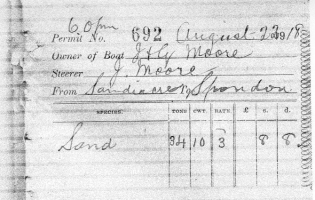
We know that the 2 narrow boats were still in use in the 1920's as we
have snapshots with them in the background under the arch of the Clock
Warehouse in Shardlow, still bearing the name Moore - the image is very
much enlarged from one of the snapshots.

John (1858 - 1940) and his wife Mary Ann (1855 - 1931) had a son Joseph
who died in France in 1917.
George (1865 - ?) and his wife Mary had at least one child - Gertrude.
We are grateful for information on the family from Joseph's great,
great grandson.
|